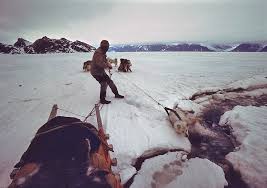The decades-long trend of extreme Arctic warming hit new heights this winter, as a mass of exceptionally warm air invaded the region, raising temperatures by almost 50 degrees Fahrenheit above average in some areas and driving temperatures above the freezing mark at the North Pole in late December. Arctic Ocean ice cover reached a new record winter low last month, putting even more stress on sea-ice-dependent seals and polar bears. Other wildlife populations, including caribou and some seabirds, are declining as species struggle to adapt to a swiftly changing polar ecosystem.
All these changes are also making it more difficult for Arctic people to put food on the table. The big Arctic melt is having a profoundly negative impact on many indigenous hunters, who for millennia have relied on the pursuit of whales, seals, fish, and land mammals such as caribou to feed their families. Even today, in an era of greater government support of far northern Native communities, indigenous people across the Arctic — from the Inuit of Canada and Greenland to the Yupik and Dene of Alaska — still depend heavily on subsistence hunting.
Now, as sea ice becomes an increasingly unreliable hunting platform and soaring temperatures alter the life cycles and abundance of prey species, some indigenous communities are facing worsening food shortages and a lack of proper nutrition. Last year, the U.S. government had to ship in frozen fish to Alaska communities whose walrus hunts had failed.
In northern Greenland, where hunters often use sled dogs, some owners have been forced to kill the animals because it is too costly to continue feeding them given the paucity of prey on their hunts.

